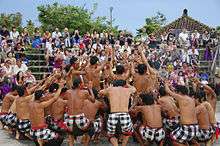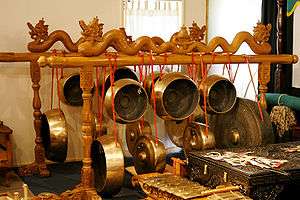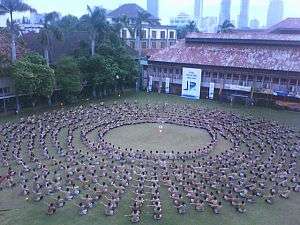Kecak
| Kecak |
|---|
 Kecak dancers in Uluwatu |
|
| Burma |
| Cambodia |
| Indonesia |
| Laos |
| Malaysia |
| Philippines |
| Thailand |
| Vietnam |
Kecak (pronounced [ˈketʃaʔ] ("Kechak"), alternate spellings: Kechak and Ketjak), known in Indonesian as Tari Kecak is a form of Balinese hindu dance and music drama that was developed in the 1930s in Bali, Indonesia. Since its creation it has been performed primarily by men, with the very first women's kecak group starting in 2006.[1] The dance mainly plays about the Ramayana and is traditionally performed in temples and villages across Bali.
Also known as the Ramayana Monkey Chant, the piece, performed by a circle of at least 150 performers wearing checked cloth around their waists, percussively chanting "chak" and moving their hands and arms, depicts a battle from the Ramayana. The monkey-like Vanara led by Hanuman helped Prince Rama fight the evil King Ravana. Kecak has roots in sanghyang, a trance-inducing exorcism dance.[2]
History
Kecak was originally a trance ritual accompanied by male chorus. In the 1930s, Walter Spies, a German painter and musician, became deeply interested in the ritual while living in Bali. He adapted it as a drama, based on the Hindu Ramayana and including dance, intended for performance before Western tourist audiences.
This is an example of what James Clifford describes as part of the "modern art-culture system"[3] in which, "the West or the central power adopts, transforms, and consumes non-Western or peripheral cultural elements, while making 'art,' which was once embedded in the culture as a whole, into a separate entity."[4] Spies worked with Wayan Limbak, who popularized the dance by arranging for performances by Balinese groups touring internationally. These tours have helped make the kecak internationally known.
| Music of Indonesia | |
|---|---|
 Kempul gongs from Java | |
| Genres | |
| |
| Specific forms | |
| Regional music | |

I Wayan Dibia, a performer, choreographer, and scholar, suggests, by contrast, that the Balinese were already developing this form when Spies arrived on the island.[5] For example, during the 1920s, the well-known dancer I Limbak had incorporated Baris movements into the cak leader role. "Spies liked this innovation," and he suggested that Limbak "devise a spectacle based on the Ramayana," accompanied by cak chorus rather than gamelan, as would have been usual.[2]
Performance

The Kecak dance is likely to be consists of about fifty to one hundred men wearing only loin-cloth, the upper part of their bodies are left bare. They form rows of circles, in the middle of which is a traditional Balinese coconut oil lamp. First they move their bodies rhythmically to the left and to the right, chanting the words "chak ke-chak ke-chak ke-chak" continuously, in slow rhythm. Gradually the rhythm is speeded up and by turns they lift their hands, trembling, into the air. The kecak dance is performed for dance-dramas and the story presented is taken from the Ramayana Hindu epic. The kecak dance is used to present the Ramayana dance-drama, the bare-chested male Kecak chanters play as Rama's troops of Vanaras (apes) and also as Ravana's troops of Rakshasas (giants).
The duration of the performance is usually one hour and it depicts the story of the Ramayana from the point of Sita and Rama during their exile in the jungle of Dandaka. It then is followed by the appearance of the Golden Deer, the abduction of Sita by Ravana, the battle between Ravana and Jatayu, the search for Sita by Hanuman, and is ended by the battle between Rama and Ravana. The Kecak chanters in this stage chant and sing accordingly to the mood and milieu of the story taking part.
Kecak dance performances in Bali usually take part daily in the evening (6 pm) at Balinese hindu temples such as in Uluwatu Temple and Tanah Lot. There are also Dance stages meant only for the Kecak performance such as in Ubud, Garuda Wisnu Kencana, Batu Bulan, Pandawa beach and other places in Bali. The kecak performance is also conducted in other occasions, usually for cultural and entertainment display. Dancers performing usually come from local villagers of the surrounding area of the performance. The dancers usually have a main job other than performing the Kecak dance, they dance usually after finishing their main job. The dancers income from the dance usually comes from the ticket sold to the spectators of the Kecak dance. The most popular destination for the Kechak dance performance takes place at Uluwatu Temple.[6]
The dance is then usually concluded after the depiction of the battle between Rama and Ravana or after the burning of Hanuman by Ravana's servants like the one performed in Uluwatu Temple, then Hanuman brings Sita to Rama. After the performance, spectators are usually invited to take a picture with the dancers.
Dancers
The dancers consists of two types in the Kecak dance, which are the Kecak male-chanters and the main Ramayana dancers who play as Sita, Rama, Lakshmana, Ravana, Hanuman, Jatayu, etc. The Kecak male-chanters who chant chak-chak-chak some have their own tasks during the performance. One individual is tasked for maintaining the beat of the chant with the chanting of "po-po-po", it is usually done by a single man. The other task is done by a man who become the leader of the chorus, he is tasked for instructing the chorus to stop or to start the chanting by yelling command vocals such as "Diih!", "Chiaaat!", etc. After that, there is the man who is tasked for singing during the chanting, he sings with a melodious and rhythmical tone according to the situation of the dance such as "Shiiir-yang-ngger-yang-nggur-yang-nggeer" and other melodies. Then, there is another man who become as the Dalang who is tasked to narrate the story during the dance usually in Balinese language and Sanskrit, he plays as the narrator of the performance. Men chosen for these tasks are usually the senior male dancers. The remaining chanters chant "chak-chak-chak" continuously and simultaneously.
The dancers who play as the core Ramayana figures are also considered to be an essential part of the dance. Rama, Sita, Lakshmana, and the Golden Deer is sometimes played by female in this situation because the movements is needed to be soft and smooth which is only trained for women not for men, men rather play as muscular figures such as Ravan, Hanuman, Sugriv, etc.
Trance
Trance rituals is usually accompanied in the Kecak dance during certain phases. Such as during the act of the burning of Hanuman which is followed by the Fire kicking known as the Fire dance is accompanied by a Trance phase by the dancer of Hanuman where he is blessed by the priest before the act. The dancer during that phase does not feel any pain from the fire because is in the stage of Trance.
In popular culture
Excerpts of kecak can be heard on the soundtracks of the following movies:
- Edipo Re by Pier Paolo Pasolini (1967)
- Fellini Satyricon (1969).
- Incontro d'amore (1970).
- The 1971 version of Kenneth Anger's Rabbit's Moon
- I Never Promised You a Rose Garden, (1977)
- The 1982 Japanese Metal Hero Series, Space Sheriff Gavan episode 6: "The Geniuses of the Makuu School"
- The soundtrack to the Coen Brothers' 1984 debut film Blood Simple includes a track entitled "Monkey Chant" which is based on kecak.
- Dagger of Kamui (Kamui no Ken) (1985)
- Akira (1988), which also features the Indonesian gamelan.
Scenes including dance may be glimpsed in
- David Attenborough's 1969 BBC documentary, The Miracle of Bali, (episodes 1 and 3).
- the Italian movie, Incontro d'amore (1970).
- the Indonesian movie, Mama (1972).
- An extended Kecak chant scene is featured at the end of Emmanuelle 2 (1975)
- the Indonesian movie, Noesa Penida (1988).
- Ron Fricke's film Baraka (1992).
- Tarsem Singh's film The Fall (2006).
- The Indonesian television station, Bali TV, uses the Kecak chanting audio with the visuals of Rangda and Topeng Tua mask dances in their program's opening theme sequence since 2011.
Kecak is found on video games:
- Sounds of gamelan and kecak chants were incorporated into the soundtrack of 1993 video game "Secret of Mana" / "Seiken Densetsu II" (track titled "The Oracle")
- A sample of Kecak chanting mixed with Balinese Gamelan can be heard in the SNK Neo Geo arcade video game, "The King of Fighters '97" when the gameplay shows Bali arena scene. The arena also includes background animation of Kecak chanters on the right side, Barong dance on the center, and Gamelan performers with crowded audience on the left side.
The “Remaya Monkey Chat” is referenced in the popular 2004 film “Mean Girls” (2004).
...and on music albums:
- A sample of Kecak chanting is in "The Wind Chimes," from Mike Oldfield's 1987 album Islands.
- The Indonesian song "Kembalikan Baliku" written by Guruh Sukarnoputra and performed by Yopie Latul for World Popular Song Festival 1987 in Tokyo, Japan, incorporates Kecak chanting in the interlude part performed by backing vocals. At the same time the song received Kawakami Audience Selection Award (ASA).[7][8]
- The San Francisco art rock band Oxbow's songs "Daughter" and "Daughter Bent & Floating" from their 1991 album King of the Jews, incorporates Kecak-inspired polyrhythmic chanting and clapping.
- Mike Patton performs a Kecak-like chant in the song "Goodbye Sober Day" on the 1999 Mr. Bungle album California.
- A sample of Kecak chanting can be heard in the song "Soldier of Fortune" from Manhattan Transfer's album Bodies and Souls.
- A sample of Kecak chanting can be heard in the Nurse With Wound track "I Cannot Feel You as the Dogs Are Laughing and I Am Blind" from the album Homotopy to Marie.
The sound of kecak has inspired other artists:
- John Adams' opera, A Flowering Tree (2006), features Kumudha and the beggar minstrels in Act II, which are based on the Kecak. (per Cincinnati Opera pre-performance interview with the composer, 30 June 2011.)
- Ketjak is a book-length poem by Ron Silliman published in 1978 and reprinted in The Age of Huts (2007), in which the author gives the title "Ketjak" to a vast ongoing cycle of works which includes Tjanting (1980) and The Alphabet (2008).
Bibliography
Sources
- ↑ "Cultural Liberty Under Spotlight at Women Playwrights", Jakarta Post, 3 December 2006, accessed 13 August 2010
- 1 2 Michel Picard (April 1990). "'Cultural Tourism' in Bali: Cultural Performances as Tourist Attraction, Indonesia" (Vol. 49 ed.). Southeast Asia Program Publications, Cornell University: 37–74.
- ↑ James Clifford, The Predicament of Culture: Twentieth-Century Ethnography, Literature, and Art (Cambridge and London: Harvard University Press, 1988), p. 223. Cited in Yamashita (1999), p.178.
- ↑ Shinji Yamashita. "Review: Michel Picard, Bali: Cultural Tourism and Touristic Culture", Indonesia, Vol. 67, (Apr., 1999), pp. 177–182. Southeast Asia Program Publications, Cornell University.
- ↑ David W. Hughes, "Review: Kecak: The Vocal Chant of Bali, by I Wayan Dibia", British Journal of Ethnomusicology, Vol. 6, (1997), pp. 195–195. British Forum for Ethnomusicology.
- ↑ https://www.youtube.com/watch?v=mGIlkmQX-g0
- ↑ http://users.telenet.be/wpsf/WPSF1987.htm
- ↑ http://www.yamaha-mf.or.jp/history/e-history/wpsf/wpsf18.html
- ↑ Review: [untitled]. Author(s): David Harnish. Reviewed work(s): Kecak from Bali by David Lewiston.Ethnomusicology, Vol. 35, No. 2, (Spring – Summer, 1991), pp. 302–304. Published by: University of Illinois Press on behalf of Society for Ethnomusicology
External links
- Kecak dance documented by Japanese television in 1999
- Kecak dance being performed in Uluwatu temple
- Kecak dance
- Kecak dance in David Attenborough's 1969 BBC documentary, The Miracle of Bali
| Wikimedia Commons has media related to Kecak. |
- Treasures of the Asia Collections: The Ketjak Dance, Cornell University
- Bali Honeymoon: A Photo Gallery – Bali's Kecak Dance photo gallery
- WalterSpies.com – Describes Walter Spies' house in Bali and his Pita Maha artists' cooperative.
- UbuWeb Ethnopoetics: Ketjak: The Ramayana Monkey Chant
.svg.png)
